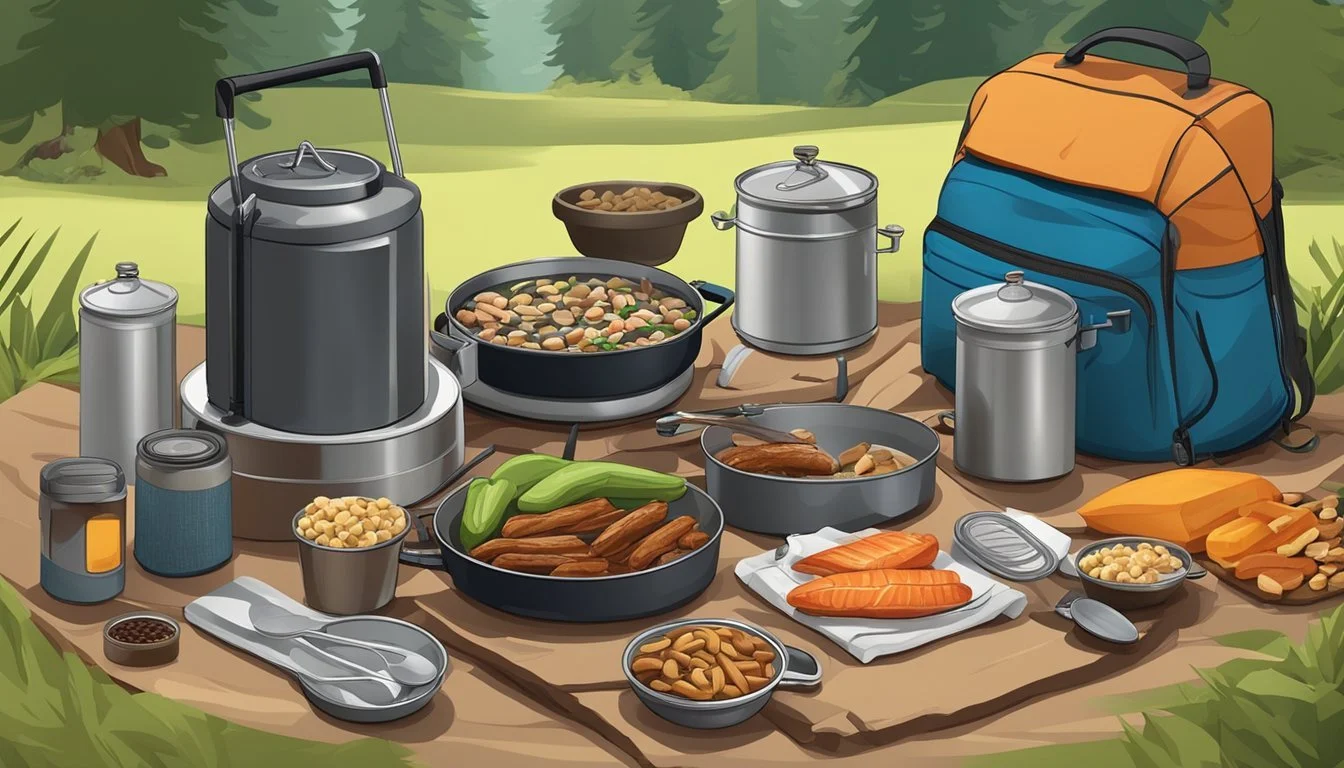The Carnivore Diet for Backpackers
Optimize Your Hike with High-Protein Trail Foods
Backpackers embarking on strenuous trails require a diet that supports their high-energy demands. The carnivore diet, which emphasizes the consumption of meat and other animal products, caters to outdoor adventurers seeking nutrient-dense, high-protein foods. This diet focuses exclusively on meat, promising to provide the sustained energy needed for long treks and challenging climbs. Protein serves as a critical macro-nutrient that aids muscle repair, growth, and overall metabolic functions—vital for the endurance backpackers rely on.
The benefits of adopting a carnivore diet while backpacking extend beyond just meeting protein needs. Meats such as chicken, beef, and fish are not only rich in protein but also provide essential fats that can be efficient fuel sources for the body. This aspect of the carnivore diet aligns with the focus of backpackers on maintaining energy levels without carrying excess weight in their packs. High-protein foods, which are at the heart of the carnivore diet, can contribute to feeling fuller for longer periods, reducing the need for frequent stops to eat.
Boarding on a path less traveled, backpackers following the carnivore diet must select meats that are non-perishable, lightweight, and easy to prepare in the backcountry. From dehydrated meat options to smoked and cured forms, the variety available enables backpackers to enjoy hearty meals without compromising on taste or nutrition. The reliance on meat-based sustenance reflects a straightforward approach to trail nutrition — one that is clear-cut and primed for the energy output of long-distance hiking.
Fundamentals of the Carnivore Diet
The Carnivore Diet is a meat-centric approach to food intake, focusing exclusively on animal products and eliminating plant-based foods. It is rich in proteins and fats, which are essential nutrients for sustained energy—key for backpackers needing endurance on the trail.
Defining the Carnivore Diet
The Carnivore Diet concentrates on consuming animal-derived products such as beef, pork, chicken, fish, and eggs. Unlike omnivorous or plant-based diets, it excludes all forms of vegetables, fruits, grains, nuts, and seeds, proposing a dietary pattern reminiscent of what some believe our ancestors followed.
Potential Benefits for Backpackers
For backpackers, this diet's high protein and fat content can provide sustained energy and reduce the need for frequent meals. The absence of carbohydrates may lead to ketosis, a state where the body breaks down fat for fuel, potentially resulting in improved mental clarity and weight loss.
Understanding Macronutrients
Protein and fats are the cornerstone macronutrients of the Carnivore Diet. These are associated with:
Muscle repair and maintenance
Long-lasting energy supply
Satiety, reducing overall food consumption needs
This diet does not include carbohydrates, which are the body's preferred energy source but can be replaced by fats during ketosis.
Micronutrients and their Sources
Essential nutrients such as vitamins and minerals can be sourced from:
Organ meats (rich in iron, zinc, and B Vitamins, including B12)
Fatty fish and eggs (providing Vitamin D and omega-3 fatty acids)
Bone broth (a good source of electrolytes and minerals)
Hydration and the Carnivore Diet
Water consumption remains pivotal, as the Carnivore Diet is naturally low in foods with high water content. Adequate hydration is crucial, and backpackers may need to increase water intake to compensate for the absence of fruits and vegetables, and to support the body's adaptation to a higher protein intake, which demands more water for metabolism.
Food Selection and Preparation
Selecting the right foods and preparing them effectively is crucial for backpackers following a carnivore diet to maintain energy levels and meet nutritional needs during their adventure.
Selecting High-Quality Meats
For sustained energy and nutritional value, backpackers should focus on high-protein meats like grass-fed beef, organic chicken, fresh fish, and pork. Grass-fed beef is a favorable choice due to its higher omega-3 content and overall nutrient profile. Fish like salmon and sardines are lightweight options and serve as excellent sources of omega-3 fatty acids.
Preparing and Packing Meat for the Trail
Backpackers must adhere to methods that ensure meats are lightweight and non-perishable. Jerky (beef jerky, salmon jerky), smoked meats, cured meats (What wine goes well with cured meats?) like salami, and bacon are ideal for their ability to be preserved. Meat should be portioned in vacuum-sealed packages to minimize space and maximize freshness.
Incorporating Organ Meats
Organ meats, including liver, kidneys, and marrow, should be considered for their rich nutrient profile. Dried organ meat products are available and can be added to meals for variety and a boost in essential vitamins and minerals.
Dairy Options for Backpackers
While on the trail, backpackers can include dairy as a source of fat and calories. Selections may include hard cheeses like cheddar, which are durable and less prone to spoilage, and soft cheeses (What wine goes well with soft cheeses?) in wax packaging. Butter can be used for cooking and adds flavor and calories.
Cooking Methods and Tools
The ability to cook is variable on the trail; thus, backpackers should have lightweight cooking tools. Meals can be prepared using portable stoves or simple fires. Ingredients like boiled eggs, steaks, chops, and chicken thighs are typically cooked quickly over a flame.
Ensuring Food Safety
Ensuring safety with meat consumption on the trail is vital. Methods like smoking, curing, and drying reduce moisture that bacteria require to grow, effectively preserving the meat. Backpackers should prioritize food safety by utilizing cool packs for perishables and ensuring all meats are cooked to the appropriate internal temperatures to prevent foodborne illness.
Nutrition and Supplement Considerations
When backpacking on the carnivore diet, individuals should prioritize a high intake of proteins and fats from animal sources while also addressing potential nutrient deficiencies and hydration needs.
Meeting Protein and Fat Needs
Backpackers on a carnivore diet focus on high-protein and high-fat foods for sustained energy on the trail. Key sources include:
Beef: Steaks and ground beef offer rich protein.
Pork: Provides variety with options like ribs and bacon.
Eggs: A versatile source of fat and protein.
Salmon: Delivers high-quality protein and omega-3 fatty acids.
Tallow: Can be used as a cooking fat with added caloric density.
Take advantage of the wide variety of online options when shopping for a tallow!
Addressing Possible Nutrient Gaps
Despite the nutrient density of meat-based diets, certain vitamins and minerals commonly found in plant foods might be less abundant. Pay attention to:
Vitamins: A and E, commonly found in organ meats.
Minerals: Zinc and selenium, present in seafood and meat.
Essential nutrients such as vitamin C can be sourced from fresh, raw meats or organs like liver.
Supplements and the Carnivore Diet
Supplementing may be crucial for some individuals to maintain a balanced nutritional profile. Consider:
Magnesium: Can be found in bone broth; supplementing may be beneficial.
Vitamin Supplements: Particularly for vitamins that might be in lesser amounts on a carnivore diet.
Get the best value for your money by purchasing magnesium online!
Hydration and Electrolyte Management
Maintaining hydration and managing electrolytes are vital:
Water: Consume an ample amount; requirements can increase due to high protein intake.
Salt and Electrolytes: Necessary for muscle function and hydration; consider adding salt or an electrolyte supplement to your regimen.
Trust me, the easiest way to buy electrolyte supplement is through online retailers!
Practical Tips for Backpacking
When embarking on a backpacking trip with a carnivore diet focus, it's essential to optimize meal planning, energy management, logistics, cooking techniques, and trail etiquette to ensure a successful and environmentally responsible journey.
Meal Planning and Portion Control
For carnivore diet backpackers, meal planning revolves around high-calorie, high-protein, and high-fat foods. These backpackers should allocate their portions based on the length of the trip and their daily caloric requirements. Snacks like beef jerky or pemmican are excellent for their balance of protein and fat, easy storage, and lightweight characteristics.
Sample Meal Planning Table
Breakfast
Protein Source: Canned fish
Calories: 200
Weight: 100g
Lunch
Protein Source: Pemmican
Calories: 400
Weight: 70g
Dinner
Protein Source: Freeze-dried venison
Calories: 500
Weight: 90g
Snacks
Protein Source: Jerky
Calories: 100
Weight: 30g
Energy Management on the Trail
Maintaining energy on the trail requires attention to the calorie deficit created by physical exertion. Backpackers should consume adequate fat and protein for sustained energy levels. Carnivore-friendly snacks that are high in these macronutrients can be consumed between meals to mitigate energy dips.
Logistics of Carrying Meat
When carrying meat products, preservation and storage are paramount. Vacuum-sealing meat and utilizing dehydration methods can extend the shelf life of foods. Prioritizing lightweight, non-perishable foods such as dehydrated meats minimizes pack weight and reduces spoilage risk.
Wilderness Cooking Techniques
Cooking in the wilderness demands efficient methods. Backpackers should master the art of fire building and familiarize themselves with portable stoves. Techniques like boiling or pan-searing using minimal cookware are suited for trails. It's crucial to minimize cooking time to conserve fuel.
Campsite and Trail Etiquette
Backpackers must adhere to Leave No Trace principles to maintain the integrity of nature. This includes proper waste disposal, minimizing campfire impacts, and respecting wildlife. Pack out all trash, and when cooking, ensure that all food scraps are eliminated to avoid attracting animals.
The Environmental Impact of Meat Consumption
As backpackers explore nature, it is vital to consider the environmental effects associated with their dietary choices, particularly the consumption of meat which has consequences for sustainability and wildlife ecosystems.
Sustainable Meat Consumption
Grass-fed and organic meats are often touted as more sustainable options than their conventionally farmed counterparts. Meat from grass-fed animals is argued to be better for the environment because these animals graze on natural pastures, which can lead to soil regeneration and less dependence on synthetic feeds. On the other hand, sustainability challenges arise from the fact that grass-fed systems typically require more land, which can lead to deforestation and habitat loss if not managed responsibly.
Grass-fed Meat: Potential benefits include improved soil health and reduced greenhouse gas emissions, compared to grain-fed livestock operations.
Organic Practices: They limit the use of synthetic pesticides and fertilizers, thus reducing pollution and preserving water quality.
Impact on Wildlife and Ecosystems
The expansion of agricultural land for livestock production has a significant impact on wildlife conservation and habitat protection. Encroachment into forests and wildlands to create pasture can lead to habitat destruction, thereby threatening biodiversity. Additionally, the fragmentation of habitats makes it more difficult for species to migrate and repopulate, which can have detrimental effects on local ecosystems.
Habitat Loss: Conversion of forests into grazing land disrupts ecosystems.
Biodiversity: Reduced habitats can lead to a decline in wildlife populations and plant variety.
In addition to these pressures, backpackers consuming meat must be aware of the water and feed resources required to raise livestock, as this can contribute to higher carbon footprints and strain on natural resources.
Challenges and Considerations
Adopting the carnivore diet as a backpacker necessitates careful consideration of potential health risks, the impact on social life and lifestyle, and the financial implications of maintaining such a diet on the trail.
Potential Health Risks
The carnivore diet, while high in protein, often lacks the fiber and vitamins found in plant-based foods. Backpackers have to manage dietary restrictions that can lead to imbalances. Sustained consumption of exclusively animal products can increase cholesterol, posing a risk to heart health. It's crucial to consult a healthcare professional to ensure this high-meat diet doesn't jeopardize one's health.
Social and Lifestyle Impact
Socially, those following a carnivore diet might experience difficulties during group activities where meals are shared. Events like communal dinners or potlucks pose a challenge, as their dietary restrictions limit participation in the variety generally found in group settings. It may also affect relationships with peers who have different dietary habits, as dietary choices can be a significant aspect of one’s social life.
Cost Factor of a Meat-Heavy Diet
When budgeting for a backpacking trip, the expense of a meat-heavy diet cannot be overlooked. Meats are typically more expensive than plant-based options, influencing the affordability of the carnivore diet. Backpackers must plan their budget carefully to manage the higher costs while ensuring they have enough nutrient-dense and high-energy foods for sustenance on the trail. Comparing costs across different types of animal products and purchasing in bulk can help in keeping the diet more affordable.








